Female Erasure in X-Men: Days of Future Past
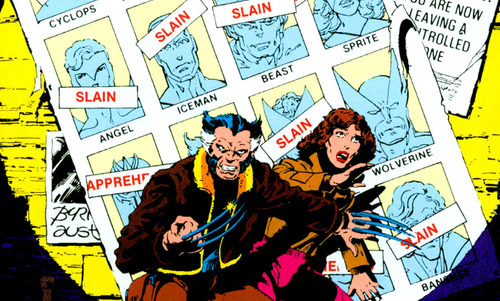
[This essay features major spoilers for X-Men: Days of Future Past]
A portion of my review was dedicated to this subject, but it’s time I go deeper into the resounding sexism in place in X-Men: Days of Future Past. My review simply covered a minuscule portion of what left me uncomfortable while watching the film; specifically, how a film series could go from poorly writing its female characters to excluding them completely. Basically, for those of you who missed it in the film or are simply reading this despite my spoiler warnings, what Bryan Singer and Simon Kinberg did with DoFP was erase every female mutant from the past, with one exception.
Every time I’ve brought up the stunning lack of women in DoFP, someone always brings up one name: Mystique. Oh, how I’d love to discuss Mystique’s role in DoFP. A role that means next to nothing outside of being the puppet that two immature men are fighting over. A puppet that doesn’t deserve agency unless a man tells her she’s free to have it. A puppet whose sole goal in a moment of independence is appropriated by a man more interested in his own personal agenda than her own well being. So this puppet, deserving of so much more than what she got, is exactly who we’ll start with.

Let’s talk about Mystique, or rather: Raven Darkholme. Simply by jumping onto her Wikipedia page, you can find out a mountain of information about Raven that the films have never shown. For instance, she is of few bisexual characters in the X-Men comics; a quality I’m almost glad has been gleaned over in the cinematic universe because of just how sexualized she is. Her independence has led her to have control over rogue-ish mutant groups, those who prefer not to align themselves with either Charles (Professor X)or Erik (Magneto). In other words, she’s a boss queen who hasn’t been given much to do on film except look good and be part of a lazily written love triangle where she has to submit to one man’s ideals or the others. “But wait Juan! Mystique was the one who wanted to go about killing Peter Dinklage’s Dr. Trask in the first place!” Dang, you really got me there. Except, you didn’t. It’s like a friend of mine put it, “There’s taking away someone’s agency and then there’s throwing it on the ground and grinding it into the dirt with your shoe.” The situation that unfolds with Mystique is very clearly the latter.
Up until the moment that Charles and Erik intervene in Mystique’s plan, I was fully on board with her characterization. Did I find it a little frustrating that she never bothered to don an outfit reminiscent to the white one she wears in most comics (even though it’d fit in pretty nicely with the aesthetic the film was going for)? Of course I did. But the blue “natural skin” that she struts around in solely to please the male viewers brings in the cash, and they’ve been doing it since Rebecca Romijn starred as her. Her disguises work just fine for her, as they always seem to, until the three mutants (and others) clash at Trask’s sentinel meeting. In this scene, one would believe that for one minute, Raven would drop right out of the love triangle she was forced into by bad writing. She doesn’t agree with Charles’ decision to try and stop her from killing Trask, but, simultaneously, she was just shot and hunted down by Erik. In that very moment, her own path should have been solidified. Instead, she ends up at the mercy of those same two contrasting ideologies again by the end of the film.
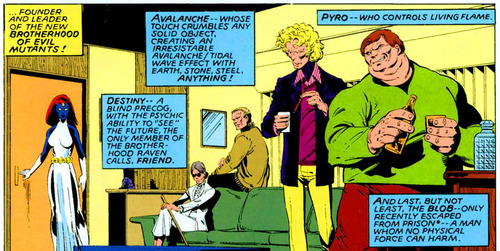
I find it interesting that many people say that Raven kept as big a role as she did in the comic series, but what those people fail to realize is that her role (while supposedly pumped up to fill more screen time) had little of what made her an interesting character. She was her own independent force, she had her Brotherhood, she was a leader. At no moment does she rally together the mutants that she has freed in the film to follow her as the independent, manipulative, leader she so very clearly is (seriously, read a single X-Men comic that she’s featured in). No, she ends up letting Charles coax her out of something and into something else. She shows that she only knows how to fawn over the men who relentlessly hunted her down (and one who assaulted her) mere minutes before the final act unfolds, and that she’s willing to submit to the desires of a man who only exists to suppress her. Charles claims that Raven came to the decision to not kill on her own, but considering she had a man inside her head during the time she was attempting to make her decision, it comes off like bullshit. She doesn’t get to have her own agenda. Her agenda has to come from either Charles or Erik. Every bit of agency she could have had in the film was taken from her. Rather than stand as a figure that can never be policed by society — be that society mutant or human — Raven’s sole existence in the film is to stand as a figure for Charles and Erik to manipulate as much as they please.
One of DtHL’s contributors, Chris Mello, spent some time the other day on Twitter discussing how the Marvel Cinematic Universe (including that of non-Disney properties) needs to desperately learn from Marvel Comics. “Not just in terms of formal range, but in content and politics too. X-Men movies work as a metaphor for marginalized groups, but the comics actually include mutants of all orientations, gender, and races. Then, MCU has no strong female leads. Yet She-Hulk, Captain Marvel, and the all-female X-Men team [among others] are killing it. The comics even go so far as to represent the entire universe as having a non-binary gender.1” While the latest X-Men film is not a part of Marvel’s Cinematic Universe, it could still serve to learn something from the comics it’s based on rather than simply pulling an idea and rewriting the actual tale into oblivion.
Unsurprisingly, this quote applies amazingly to what they’ve done with Mystique’s character over the entire X-Men series. While we’ve already discussed exactly what problems come with her Days of Future Past narrative, one thing that has been ignored throughout the entire film series is Raven’s sexuality. Her bisexuality is all but erased (which should not shock anyone considering the history of bisexual erasure on screen; always being limited to “straight” and/or “gay”) and her romantic interests are limited to two men: Charles and Erik. No mention of Destiny (Irene Adler) whatsoever and not even the slightest hint at the fact that she might be interested in women. Her being played by Jennifer Lawrence, a woman who dismisses her sexuality by saying she went through a “lesbian phase,” just adds to the frustration. Is it possible that this part of Raven’s character will be explored in the impending Apocalypse film, especially with its rumored 80s timeline? Of course. But I won’t keep my hopes high.
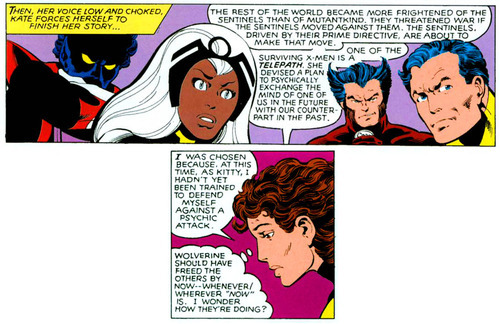
Enough about Raven though, let’s move on to the already much-discussed Kitty Pryde, as well as the rewriting of Chris Claremont and John Byrne’s original narrative. Stephen Burt at Slate wrote what I believe is one of the best pieces detailing what exactly was wrong with X-Men Days of Future Past. This review of sorts is told through the perspective of Kitty, focusing on the removal of women from the forefront of the film, specifically Kitty herself. To quote:
“Future-me spends almost the whole movie silently poised at Wolverine’s temples, using my powers to send him back into the body of his younger self, into 1973, when he gets to talk Charles Xavier and a couple other mutants into preventing an assassination.”
Anyone who has read the comic knows that Rachel Summers (or Rachel Grey if you prefer), who is non-existent in the film series due to Simon Kinberg’s disastrous The Last Stand script and its killing of Scott Summers and Jean Grey, is the one who sends Kitty back to the past. For some reason, the transference of this consciousness travel power to Kitty makes sense, but sending her back doesn’t. Wolverine (Logan) is only allowed to go back because the time travel won’t destroy his body. Or something like that. It’s a lazy excuse, but why bother questioning anything in a film with as many plot holes in the now-erased alternate timeline as this one has? The excuse given for this massive change was essentially that they needed to thin out the original narrative. The rest of the piece details many other reasons as to how something like this could have been solved, while maintaining the integrity of the way the comic pushes its female characters to the forefront. But there’s a lot outside of Kitty relating to the narrative that the piece doesn’t address.
As we read through the comic, we realize just how much more has been erased than just Kitty Pryde. What was originally a tale of Kitty going back in time to rescue her teammates from a future that led to death and despair, Ororo (Storm) trying to manage a team of mutants to push for further survival in both the past and future, and Mystique leading the brotherhood of evil mutants (and her partner Destiny) in a plot of her own, is long gone. Instead we get Quicksilver, we get Erik, we get Charles; the latter two with the same agendas that Kitty and Mystique once held. Not a single one of these three men were featured in the past segment of the comic, but in the film we get them, along with Logan, whose role is pumped up to make him the star.
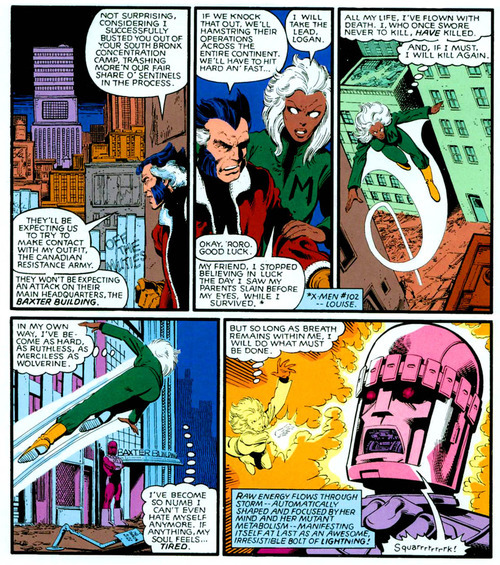
Ororo is nowhere to be found in the film’s past, and in the future she is limited to what might as well be the same amount of lines a featured extra might have. Blink, another woman of color, is present in the future as well. If we were to watch all of the future sequences back to back, she dies almost immediately. Unfortunately, neither one of them is offered any introspective moments, which is baffling considering how prevalent Storm’s role in the comic is. In both the comic and film, Storm dies at the hands of a sentinel. Where the film fails her though — as it fails every character male and female — is by relying on the films long past to make the audience interested in her death, rather than offering her a moment to shine with words instead of powers.
Now that we’re done discussing all the ways that the women of future, and Raven overall, were shafted by the filmmakers for the sake of presenting a male figure at the lead and keeping all the women out of the way, let’s talk about the dead mutants; the ones who fell in the past and shall remain that way for good (unless time travel happens again). In X-Men First Class, the four present women were Mystique (who has been discussed), Moira (a human who is never mentioned in Days of Future Past), and the two mutants whose fates were barely discussed in the film. Their names are Emma Frost and Angel Salvadore. When it comes to the first, who many deemed a lackluster character due to the poor writing in First Class, we only find out about her demise through one sentence that comes from the mouth of Erik. He essentially claims that there were many casualties between the years of First Class and Days of Future Past. She is included in the list of casualties. That’s it.
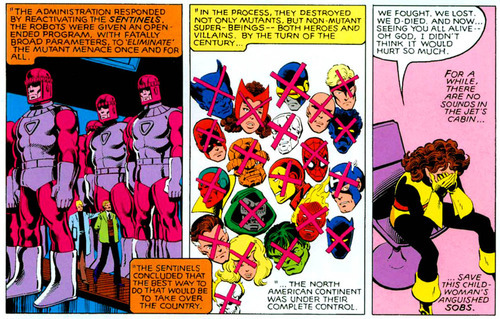
Even with the revisionist universe that Logan’s time travel created, never again will we see Emma Frost on screen (and her loss further puts into question everything that happened in Wolverine Origins, considering a young Emma Frost was featured in said film). Maybe I feel stronger about this than other people, simply because I find her character incredibly fascinating and often underwritten (as was the case in First Class), but it seems like a poor decision to simply cut out a character with as much potential as Emma Frost. Never again will we see Angel either, who instead of being listed to us, was presented as an autopsy sheet in Trask’s office. That’s it. This is what women in the scenes from the past are subjected to: off-screen death under the guise of thinning out a bloated narrative.
I’d go into detail about the limitation of Scarlet Witch, but what would be the point considering the only time Wanda’s shown is as a nameless child in the arms of her older brother Quicksilver. Would anyone know her name is Wanda? Nah. Would anyone know she’s a mutant? Nah. Would anyone know she’s supposed to be Pietro’s twin sibling? Nah. Hell, for all we know, that wasn’t even Wanda at all. All of that would involve too much work and some semblance of interest in maintaining any similarities between comic and film, and that’s not what 20th Century Fox is about. Even Captain America: The Winter Soldier did more to showcase that Wanda Maximoff is a mutant, and that’s kind of embarrassing to think about considering Marvel isn’t allowed to use the word mutant in their films.
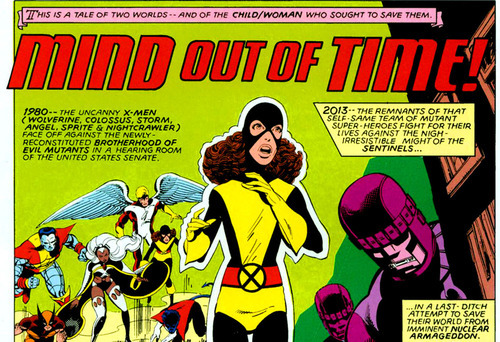
I’m not opposed to taking the concept of a comic and creating your own “what if” scenario around that same concept. Dozens upon dozens of comic writers have done just that; sometimes they work, sometimes they fail. What I’m opposed to is a comic led by a woman, in which the entire fate of the world hinges on that woman being able to manage her abilities and nudge the world into a safer place for mutants, being rewritten so that a man can be the hero. The writers for X2 — a film that is going through some sort of critical reappraisal for the sake of legitimizing the nonsense that Days of Future Past brought with it — knew how to write a film that was at least remotely balanced when it came to the male and female mutants, so why are we okay settling for less?
After years of having the tiresome Logan as the head of the film series, we’d managed to escape that in First Class. There were still two men leading the action, but at least it wasn’t Logan, and at least there were multiple women involved in the action (Moira, Raven, Emma, Angel). Instead of taking these films in a new direction, one that could be considered as inclusive and important as the comics can often be, why are we submitting ourselves to taking ten steps back? Back to a world where women don’t matter. Back to a world where men get to save everybody. This is my problem with X-Men Days of Future Past and everyone involved in its production. This should be your problem too.
—

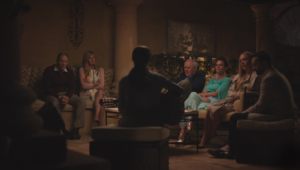

 Derek
Derek
 Isabelle
Isabelle